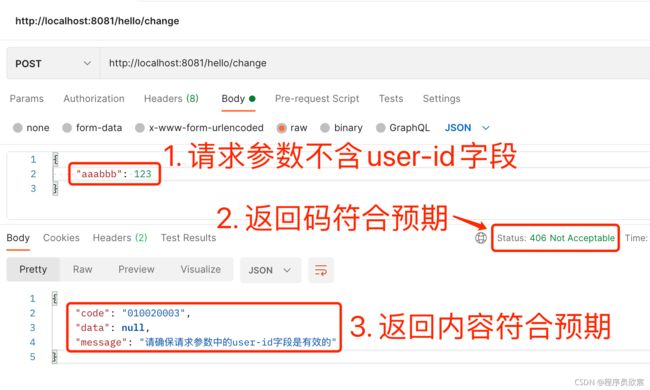欢迎访问我的GitHub
这里分类和汇总了欣宸的全部原创(含配套源码):https://github.com/zq2599/blog_demos
本篇概览
-
Spring Cloud Gateway应用中,处理请求时若发生异常未被捕获,请求方收到的响应是系统默认的内容,无法满足实际业务需求
-
因此,从前一篇文章《Spring Cloud Gateway过滤器精确控制异常返回(分析篇)》开始,咱们深入分析了Spring Cloud Gateway的相关源码,了解到全局异常的处理细节,然后,通过前文《Spring Cloud Gateway过滤器精确控制异常返回(实战,控制http返回码和message字段)》的实战,咱们已经能随意设置http返回码,以及body中的message字段,也就是控制下图两个红框中的内容:
- 正如上图所示,异常发生时系统固定返回8个字段,这就有些不够灵活了,在一些对格式和内容有严格要求的场景下,咱们需要能够完全控制返回码和返回body的内容,如下所示,只返回三个字段,每个字段都是完全为业务服务的:
{
# 这是有具体业务含义的返回码
"code": "010020003",
# 这是能精确描述错误原因的文本信息
"message": "请确保请求参数中的user-id字段是有效的",
# 这是常规的业务数据,发生异常时该字段为空
"data": null
}
- 今天咱们的目标就是通过编码定制异常发生时的返回信息,具体内容就是上述JSON数据:只有code、message、data三个字段
源码下载
- 本篇实战中的完整源码可在GitHub下载到,地址和链接信息如下表所示(https://github.com/zq2599/blog_demos):
| 名称 | 链接 | 备注 |
|---|---|---|
| 项目主页 | https://github.com/zq2599/blog_demos | 该项目在GitHub上的主页 |
| git仓库地址(https) | https://github.com/zq2599/blog_demos.git | 该项目源码的仓库地址,https协议 |
| git仓库地址(ssh) | [email protected]:zq2599/blog_demos.git | 该项目源码的仓库地址,ssh协议 |
- 这个git项目中有多个文件夹,本篇的源码在spring-cloud-tutorials文件夹下,如下图红框所示:
- spring-cloud-tutorials文件夹下有多个子工程,本篇的代码是gateway-change-body,如下图红框所示:
为何不用常规手段
- 提到全局异常处理,经验丰富的您应该想到了常用的ControllerAdvice和ExceptionHandler注解修饰的全局异常处理类,但是Spring Cloud Gateway是基于WebFlux的,咱们之前处理异常时用到的HttpServletRequest在Spring Cloud Gateway中并不适用,因此,不能用ControllerAdvice和ExceptionHandler的手段来处理全局异常
基本思路
-
在动手前做好充足的理论分析,写出的代码才能正常工作
-
打开DefaultErrorWebExceptionHandler.java,找到renderErrorResponse方法,来看看Spring Cloud Gateway原本是如何构造异常返回内容的:
- 此刻聪明的您应该想到怎么做了:做个新的类继承DefaultErrorWebExceptionHandler,覆盖其renderErrorResponse方法,新的renderErrorResponse方法中,按照实际业务需要来设置返回内容,没错,这就是咱们的思路,不过还要细化一下,最终具体的步骤如下:
-
新增一个异常类CustomizeInfoException.java,该类有三个字段:http返回码、业务返回码、业务描述信息
-
在返回异常的代码位置,使用CustomizeInfoException类来抛出异常,按照实际业务场景设置CustomizeInfoException实例的各个字段
-
新增MyErrorWebExceptionHandler.java,继承自DefaultErrorWebExceptionHandler,重写了renderErrorResponse方法,这里面检查异常实例是否是CustomizeInfoException类型,如果是,就从其中取出http返回码、业务返回码、业务描述信息等字段,构造返回body的内容,异常实例若不是CustomizeInfoException类型,就保持之前的处理逻辑不变;
-
新增configuration类,用于将MyErrorWebExceptionHandler实例注册到spring环境
- 分析完毕,开始编码吧,为了简单起见,本篇不再新增maven子工程,而是基于前文创建的子工程gateway-change-body,在这里面继续写代码;
编码
- 新增异常类CustomizeInfoException.java:
package com.bolingcavalry.changebody.exception;
import lombok.Data;
import org.springframework.http.HttpStatus;
@Data
public class CustomizeInfoException extends Exception {
/**
* http返回码
*/
private HttpStatus httpStatus;
/**
* body中的code字段(业务返回码)
*/
private String code;
/**
* body中的message字段(业务返回信息)
*/
private String message;
}
- 修改RequestBodyRewrite.java的apply方法,这里面是在处理请求body,如果检查到没有user-id字段,就不将请求转发到服务提供方provider-hello,而是返回错误,这里的错误就用CustomizeInfoException类来处理:
@Override
public Publisher apply(ServerWebExchange exchange, String body) {
try {
Map map = objectMapper.readValue(body, Map.class);
// 如果请求参数中不含user-id,就返回异常
if (!map.containsKey("user-id")) {
CustomizeInfoException customizeInfoException = new CustomizeInfoException();
// 这里返回406,您可以按照业务需要自行调整
customizeInfoException.setHttpStatus(HttpStatus.NOT_ACCEPTABLE);
// 这里按照业务需要自行设置code
customizeInfoException.setCode("010020003");
// 这里按照业务需要自行设置返回的message
customizeInfoException.setMessage("请确保请求参数中的user-id字段是有效的");
return Mono.error(customizeInfoException);
}
// 取得id
int userId = (Integer)map.get("user-id");
// 得到nanme后写入map
map.put("user-name", mockUserName(userId));
return Mono.just(objectMapper.writeValueAsString(map));
} catch (Exception ex) {
log.error("1. json process fail", ex);
return Mono.error(new Exception("1. json process fail", ex));
}
}
- 异常处理类MyErrorWebExceptionHandler.java,这里有一处需要重点关注的是:下面的代码仅是参考而已,您无需拘泥于CustomizeInfoException有关的逻辑,完全能按照业务需求自由设置返回的状态码和body:
package com.bolingcavalry.changebody.handler;
import com.bolingcavalry.changebody.exception.CustomizeInfoException;
import org.springframework.boot.autoconfigure.web.ErrorProperties;
import org.springframework.boot.autoconfigure.web.WebProperties;
import org.springframework.boot.autoconfigure.web.reactive.error.DefaultErrorWebExceptionHandler;
import org.springframework.boot.web.reactive.error.ErrorAttributes;
import org.springframework.context.ApplicationContext;
import org.springframework.http.MediaType;
import org.springframework.web.reactive.function.BodyInserters;
import org.springframework.web.reactive.function.server.ServerRequest;
import org.springframework.web.reactive.function.server.ServerResponse;
import reactor.core.publisher.Mono;
import java.util.HashMap;
import java.util.Map;
public class MyErrorWebExceptionHandler extends DefaultErrorWebExceptionHandler {
public MyErrorWebExceptionHandler(ErrorAttributes errorAttributes, WebProperties.Resources resources, ErrorProperties errorProperties, ApplicationContext applicationContext) {
super(errorAttributes, resources, errorProperties, applicationContext);
}
@Override
protected Mono renderErrorResponse(ServerRequest request) {
// 返回码
int status;
// 最终是用responseBodyMap来生成响应body的
Map responseBodyMap = new HashMap<>();
// 这里和父类的做法一样,取得DefaultErrorAttributes整理出来的所有异常信息
Map error = getErrorAttributes(request, getErrorAttributeOptions(request, MediaType.ALL));
// 原始的异常信息可以用getError方法取得
Throwable throwable = getError(request);
// 如果异常类是咱们定制的,就定制
if (throwable instanceof CustomizeInfoException) {
CustomizeInfoException myGatewayException = (CustomizeInfoException) throwable;
// http返回码、body的code字段、body的message字段,这三个信息都从CustomizeInfoException实例中获取
status = myGatewayException.getHttpStatus().value();
responseBodyMap.put("code", myGatewayException.getCode());
responseBodyMap.put("message", myGatewayException.getMessage());
responseBodyMap.put("data", null);
} else {
// 如果不是咱们定制的异常,就维持和父类一样的逻辑
// 返回码
status = getHttpStatus(error);
// body内容
responseBodyMap.putAll(error);
}
return ServerResponse
// http返回码
.status(status)
// 类型和以前一样
.contentType(MediaType.APPLICATION_JSON)
// 响应body的内容
.body(BodyInserters.fromValue(responseBodyMap));
}
}
- 最后是配置类MyErrorWebFluxAutoConfiguration.java:
package com.bolingcavalry.changebody.config;
import com.bolingcavalry.changebody.handler.MyErrorWebExceptionHandler;
import org.springframework.beans.factory.ObjectProvider;
import org.springframework.boot.autoconfigure.AutoConfigureBefore;
import org.springframework.boot.autoconfigure.condition.ConditionalOnClass;
import org.springframework.boot.autoconfigure.condition.ConditionalOnWebApplication;
import org.springframework.boot.autoconfigure.web.ServerProperties;
import org.springframework.boot.autoconfigure.web.WebProperties;
import org.springframework.boot.autoconfigure.web.reactive.WebFluxAutoConfiguration;
import org.springframework.boot.context.properties.EnableConfigurationProperties;
import org.springframework.boot.web.reactive.error.ErrorAttributes;
import org.springframework.boot.web.reactive.error.ErrorWebExceptionHandler;
import org.springframework.context.ApplicationContext;
import org.springframework.context.annotation.Bean;
import org.springframework.context.annotation.Configuration;
import org.springframework.core.annotation.Order;
import org.springframework.http.codec.ServerCodecConfigurer;
import org.springframework.web.reactive.config.WebFluxConfigurer;
import org.springframework.web.reactive.result.view.ViewResolver;
import java.util.stream.Collectors;
@Configuration(proxyBeanMethods = false)
@AutoConfigureBefore(WebFluxAutoConfiguration.class)
public class MyErrorWebFluxAutoConfiguration {
private final ServerProperties serverProperties;
public MyErrorWebFluxAutoConfiguration(ServerProperties serverProperties) {
this.serverProperties = serverProperties;
}
@Bean
@Order(-1)
public ErrorWebExceptionHandler errorWebExceptionHandler(ErrorAttributes errorAttributes,
org.springframework.boot.autoconfigure.web.ResourceProperties resourceProperties,
WebProperties webProperties, ObjectProvider viewResolvers,
ServerCodecConfigurer serverCodecConfigurer, ApplicationContext applicationContext) {
MyErrorWebExceptionHandler exceptionHandler = new MyErrorWebExceptionHandler(errorAttributes,
resourceProperties.hasBeenCustomized() ? resourceProperties : webProperties.getResources(),
this.serverProperties.getError(), applicationContext);
exceptionHandler.setViewResolvers(viewResolvers.orderedStream().collect(Collectors.toList()));
exceptionHandler.setMessageWriters(serverCodecConfigurer.getWriters());
exceptionHandler.setMessageReaders(serverCodecConfigurer.getReaders());
return exceptionHandler;
}
}
- 编码完成,该把程序运行起来验证效果了;
验证
-
启动应用gateway-change-body
-
用postman发起POST请求,地址是http://localhost:8081/hello/change,如下图,红框2中的http返回码是咱们代码里设置的,红框3显示返回的内容就是咱们定制的那三个字段:
- 至此,控制Spring Cloud Gateway应用异常返回的实战已经全部完成,从源码分析结合实战演练,希望欣宸的文章能陪伴您深入了解Spring Cloud Gateway,打造出更加强大的网关应用;
你不孤单,欣宸原创一路相伴
- Java系列
- Spring系列
- Docker系列
- kubernetes系列
- 数据库+中间件系列
- DevOps系列
欢迎关注公众号:程序员欣宸
微信搜索「程序员欣宸」,我是欣宸,期待与您一同畅游Java世界...
https://github.com/zq2599/blog_demos




